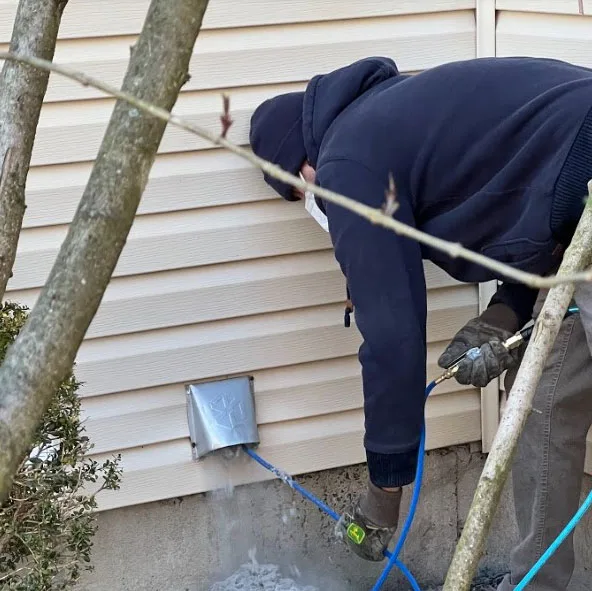When you think about home maintenance, you probably picture fixing a leaky faucet, changing air filters, or sweeping the floor. But there’s one task that often gets overlooked—and yet, it’s one of the most important for both safety and energy savings: dryer vent cleaning.
It doesn’t matter whether you’ve owned your dryer for a year or several. If you use it regularly, lint and debris build up inside your dryer vent, posing risks that many homeowners don’t even know exist, especially if the vent is blocked .
Let’s take a closer look at why this matters—and how a simple cleaning routine can help you find ways to protect your home, lower your energy bills, and extend the life of your dryer.
The Hidden Danger in Your Dryer Vent
Every time you run your washer and toss clothes into the dryer, small fibers from your clothing collect as lint. While your lint trap catches a lot, a surprising amount escapes through the vent and lodges deep inside the duct.
Over time, that buildup becomes a fire hazard—especially if your dryer vent is blocked. It also causes your machine to work harder, consuming more air and energy than needed.
According to the National Fire Protection Association, failure to clean dryer vents is a leading cause of residential dryer fires. The solution? Regular dryer vent cleaning—done the right way, which often reflects great feedback from users .
What Dryer Vent Cleaning Involves
Cleaning a dryer vent may sound simple, but it’s not just about brushing off a little lint. It’s a long duct system that may run behind your dryer, through the floor, or even up to the roof, depending on your home layout.
To do the job effectively, most professionals or DIYers use a dryer vent cleaning kit, which often includes:
- A flexible rod system
- A specialized brush to scrub the inside walls of the vent
- A drill attachment to help the brush spin (in reverse or forward direction)
- A vacuum or blower to add suction and remove debris
This tool setup allows users to reach deep into the duct system from both ends—at the dryer and at the vent access outside the house.
DIY or Hire a Company?
This is where things get interesting.
You might search a page on how to do it yourself and click on a kit someone bought with great feedback. You chose a product, read the replies, and felt like you could handle it. That’s totally fine—if the vent isn’t too long, if it doesn’t bend sharply, and if you have the tools.
But in many cases, a DIY cleaning doesn’t fully remove all the lint, especially from tight corners or extended runs, which may be needed for thorough cleaning .
That’s why many people add this task to their annual home maintenance calendar and hire a vent cleaning company with specialized equipment. They can safely protect your home, clean deeper, and inspect for security issues like loose connections or damaged ductwork.
When Should You Clean Your Dryer Vent?
A good rule of thumb: at least once a year. But if you:
- Run your dryer several times a week
- Have pets that shed hair
- Notice clothes take longer to dry
- Smell a musty or burnt odor
- Feel heat buildup around the dryer
…it’s time to run a dryer vent cleaning sooner.
Don’t wait until you’re unable to dry your laundry efficiently. In the early stages of blockage, it’s easy to fix. But if the vent gets too clogged, it can blow lint back into your dryer, creating inside damage—or worse, a house fire.
Safety Tips for Dryer Vent Cleaning
Before you start, follow these steps:
1. Disconnect power from the dryer for safety.
2. Move the dryer to expose the back access to the vent.
3. Use a brush or vacuum to remove lint from the trap, vent pipe, and wall outlet.
4. If using a kit, insert the rod into the duct and use a drill to rotate in reverse direction.
5. Check the outside vent cover to ensure there’s no blockage.
6. Reconnect everything and continue normal use.
Always wear protective gear like gloves and a dust mask, especially when dealing with fine particles and built-up lint.
Signs It’s Time to Call a Pro
Not everyone has the right tools, patience, or experience. If your vent is especially long, travels through walls, or goes up multiple stories, you might not be able to reach the whole duct system.
Professional cleaners come equipped with reverse-blowing vacuums, inspection cameras, and industrial brush systems, including a drill for effective cleaning, to clean thoroughly and safely. They’ll check for signs of water damage, loose threads, or clogged airflow areas.
And most importantly, they’ll inspect your system to ensure it’s up to code and safe to operate—giving you peace of mind.
The Real Benefits of Dryer Vent Cleaning
1. Fire Prevention
Dry lint is highly flammable. Cleaning the vent reduces your risk of fire significantly.
2. Lower Energy Bills
A clean dryer vent helps your dryer work efficiently, using less energy to dry your clothes.
3. Faster Drying Time
No more running the dryer twice. Clean airflow means one cycle is enough, allowing you to continue with your laundry without delays .
4. Extend Dryer Lifespan
Less strain on the motor and heating element means fewer repairs and longer appliance life.
5. Improve Air Quality
Removing built-up lint helps prevent overheating, moisture, and mold that can spread through your home’s air.
One Simple Job, One Big Difference
It might seem like a small thing, but dryer vent cleaning is a powerful way to protect your home. It’s not just about energy or convenience—it’s about safety and being content with your home’s maintenance .
So whether you wanted to DIY with a kit, or you’re looking for a reliable company to handle it, don’t ignore this part of your home. Take account of how often you use your dryer, and schedule your cleanings on date.
Just like checking your air filters or giving your HVAC system a seasonal tune-up, this little job can save you from big problems.
Final Thought: Next time you’re folding fresh laundry, ask yourself—when was the last time I cleaned my dryer vent? If you can’t remember, it’s time to take action.


